Choosing between outsourcing and in-house staffing is crucial or MSPs who want to scale safely, save resources, and improve service quality. Comparing the benefits and downsides of both options, covering cost efficiency, scalability, quality control, and team cohesion brings you the necessary insight into the topic.
By getting concrete info, MSP founders can assess their specific needs, conduct a SWOT analysis, and explore the models that fit them best.
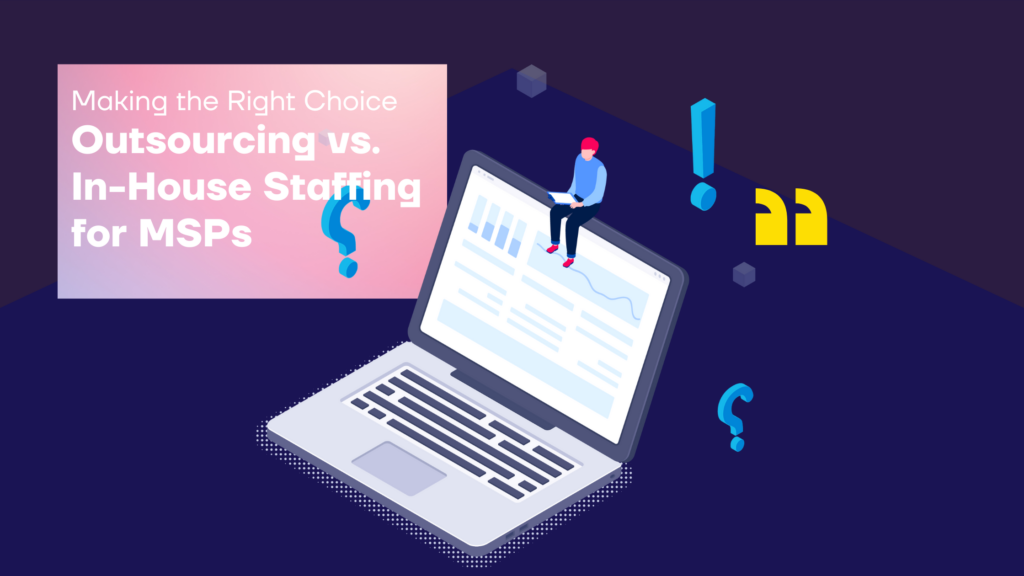
Outsourcing and In-House Staffing for MSPs
- Brief overview of the staffing challenges faced by MSPs.
- Importance of making the right choice between outsourcing and in-house staffing.
Brief Overview of the Staffing Challenges Faced by MSPs
Managed Service Providers (MSPs) often grapple with staffing challenges, from finding skilled service desk personnel to managing fluctuating workloads. It takes a lot of time to hire new in-house staff but with outsourcing models, the time and effort for hiring staff can be decimated – that’s what makes it attractive.
Balancing in-house staff with outsourced resources can be crucial in maintaining efficiency, cost-saving and client satisfaction.
Importance of Making the Right Choice Between Outsourcing and In-House Staffing
Choosing between outsourcing vs. in-house staffing affects cost efficiency, scalability, and quality control. It’s essential to identify your MSPs needs, set a goal, and have a clear image of what it takes to get there.
Weighing the pros and cons of each option helps ensure alignment with business goals and client needs.
Clear communication with MSP Staff Outsourcing Partner guarantees the best option is selected.
Defining Outsourcing and In-House Staffing
- Outsourcing. Definition and common practices in MSPs.
- In-house staffing. Definition and typical setup in MSPs.
Outsourcing: Definition and Common Practices in MSPs
Outsourcing involves contracting external personnel or services to handle specific tasks or functions within the MSP. This practice is prevalent in MSPs for roles like remote help desks and specialized IT support.
For instance, MSPs may utilize outsourced personnel for overflow support, allowing internal teams to focus on critical tasks. Outsourcing can offer flexibility and access to a broader talent pool, which is especially beneficial for MSPs needing specific expertise without the long-term commitment of hiring full-time staff. It can cover round-the-clock support, and, with a dedicated team, gives MSPs complete control of the work flow.
In-House Staffing: Definition and Typical Setup in MSPs
In-house staffing refers to employing full-time staff who work exclusively for the company. This setup offers better control over hiring processes and fosters a homogenous company culture.
For MSPs, in-house teams are often responsible for core functions such as direct client interactions, network management, and strategic planning. In-house staffing ensures that team members are integrated into the company’s operations, leading to potentially higher alignment with the company’s long-term goals.
Benefits and Downsides of Staff Outsourcing for MSPs
Detailed analysis of the pros and cons of outsourcing staff for MSPs:
Benefits of Staff Outsourcing for MSPs
- Cost efficiency. Lower labor costs and reduced overhead.
- Access to global talent. Leveraging specialized skills from around the world.
- Scalability. Flexibility to scale resources up or down based on demand.
- Focus on core activities. Allowing MSPs to concentrate on strategic business functions.
Downsides of Staff Outsourcing for MSP
- Quality control. Potential issues with maintaining consistent service quality.
- Communication challenges. Difficulties in managing remote teams across different time zones.
- Security risks. Concerns regarding data security and compliance.
- Cultural misalignment. Possible differences in work culture and ethics.
Outsourcing staff offers MSPs benefits like cost savings, access to specialized global talent, saving time, and flexibility in scaling such as a 24/7 MSP help desk or more remote help desk technicians. It enables MSPs to focus on core business activities while reducing overhead. However, if done wrong, outsourcing can have some challenges including maintaining quality, managing communication across time zones, ensuring data security, and cultural differences. Careful management and MSP staff outsourcing partner selection are essential to mitigate these risks.
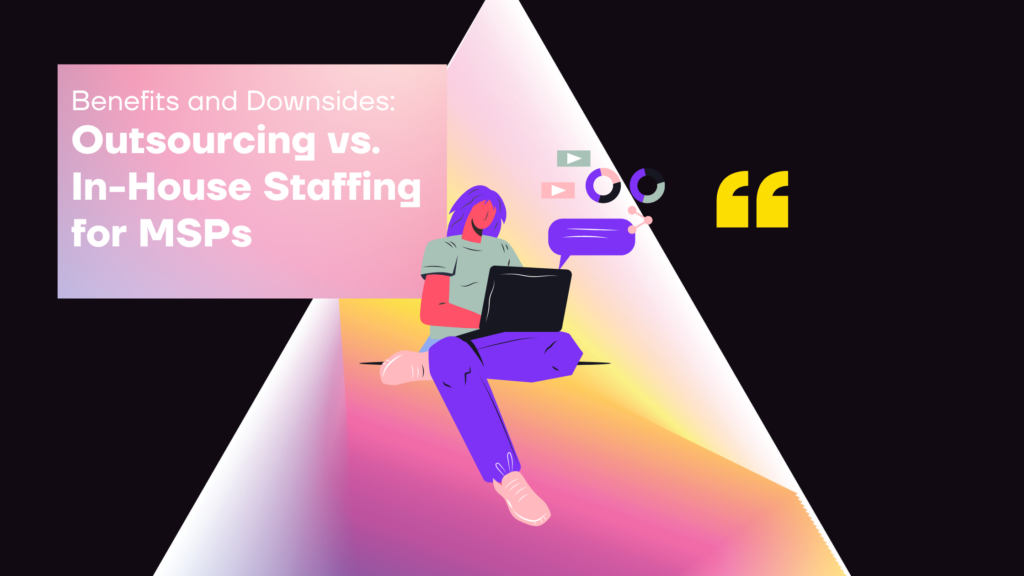
Benefits of MSP Staff Outsourcing
Cost Efficiency: Outsourcing can significantly reduce labor costs and overhead expenses. By hiring remote staff, MSPs can access skilled workers from regions with lower wage expectations, thereby saving on salaries, office space, and equipment.
Access to Global Talent: MSPs benefit from a global talent pool, gaining access to specialized skills and expertise that might not be available locally. This is particularly advantageous for specific technical roles, where expertise in niche technologies is required.
Scalability: Outsourcing offers the flexibility to scale resources up or down based on demand. This agility allows MSPs to adapt to changing client needs and project requirements without the long-term commitment of hiring full-time employees.
Focus on Core Activities: By outsourcing non-core functions, MSPs can focus on their strategic business activities, such as business development, client management, and innovation. This enables better allocation of in-house resources to high-priority tasks.
Downsides of MSP Staff Outsourcing
Quality Control: Maintaining consistent service quality can be challenging with outsourced staff. Differences in training, work standards, and expectations may lead to variable service levels.
Communication Challenges: Managing remote teams across different time zones can lead to communication delays and misunderstandings. Effective communication tools and processes are crucial to mitigating these issues.
Security Risks: Data security and compliance are major concerns with outsourcing. MSPs must ensure that outsourced personnel adhere to the same security protocols as in-house staff to protect sensitive information.
Cultural Misalignment: Differences in work culture and ethics can lead to misalignments in expectations and work processes. It is important for MSPs to select outsourcing partners that align closely with their company culture and values.
Benefits and Downsides of In-House Staffing for MSPs
Detailed analysis of the pros and cons of In-house staffing for MSPs:
Benefits of In-House Staffing
- Direct control. Greater oversight and control over staff activities and service quality.
- Aligned company culture. Better integration with the company’s values and culture.
- Immediate communication. Easier and faster internal communication.
- Team cohesion. Stronger team dynamics and loyalty.
Downsides of In-House Staffing
- Higher costs. Increased expenses related to salaries, benefits, and office space.
- Limited talent pool. Restriction to local talent and potential skills shortages.
- Scalability issues. Challenges in quickly scaling the team to meet fluctuating demands.
- Administrative burden. Additional responsibilities related to HR and management.
In-house staffing offers MSPs direct control, better integration with company culture, immediate communication, and strong team cohesion. These benefits enhance service quality and foster a cohesive work environment. However, in-house staffing also involves higher costs, limited access to a broader talent pool, challenges in scaling the team quickly, and increased administrative responsibilities. Managing these downsides requires careful planning and resource allocation.
Benefits of Staffing In-House
Direct Control: Having in-house staff allows for greater oversight and control over daily activities and service quality. MSPs can directly manage and monitor their team’s performance, ensuring alignment with company standards.
Aligned Company Culture: In-house teams are more likely to align with the company’s values and culture, leading to a more cohesive and motivated workforce. This alignment can enhance overall productivity and job satisfaction.
Immediate Communication: In-house staffing facilitates quicker and more efficient communication, as team members are in the same location or within close proximity. This immediacy can lead to faster decision-making and problem-solving.
Team Cohesion: A well-integrated in-house team can foster strong team dynamics and loyalty. Employees who work closely together tend to develop better working relationships and a shared sense of purpose.
Downsides of Staffing In-House for MSPs
Higher Costs: In-house staffing typically involves higher costs related to salaries, benefits, and office space. These costs can be a significant burden, especially for smaller MSPs.
Limited Talent Pool: Relying solely on local talent can limit an MSP’s ability to find the necessary skills and expertise. This restriction can be particularly challenging in specialized fields where local supply may not meet demand.
Scalability Issues: Scaling an in-house team quickly to meet fluctuating demands can be challenging. It often requires significant time and resources to recruit, hire, and train new employees.
Administrative Burden: Managing in-house staff involves additional administrative responsibilities, such as HR management, payroll, and compliance with employment laws. These tasks can be time-consuming and detract from focusing on core business activities.
Comparing Outsourcing vs. In-House Staffing
- Cost analysis. Detailed comparison of the costs involved in both options.
- Flexibility and scalability. Examining how each option handles growth and changing needs.
- Quality and control. Assessing the level of control and quality assurance in each setup.
- Risk management. Evaluating the risks associated with each approach.
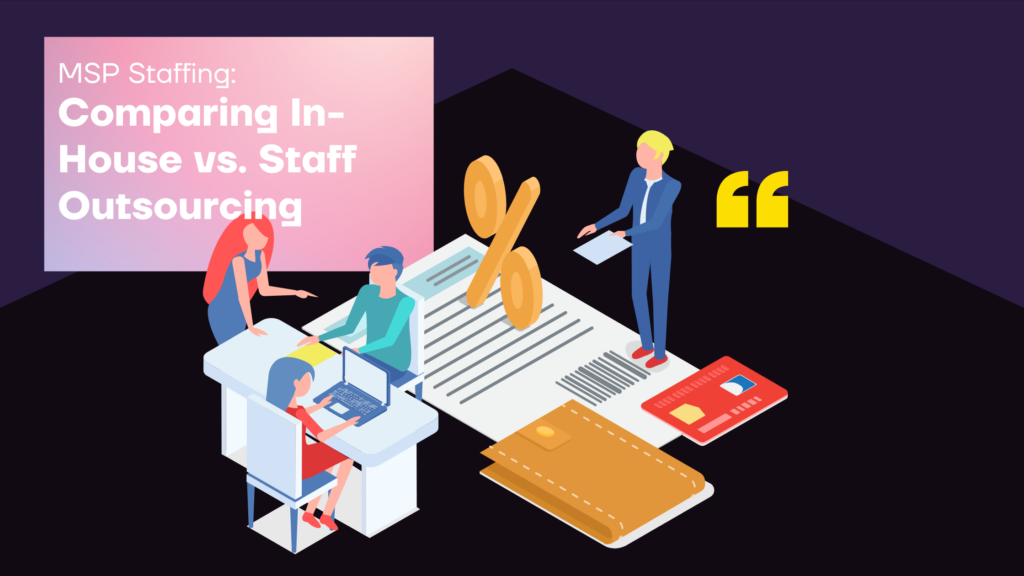
Identify the points to be considered when deciding whether to outsource or hire in-house:
Cost Analysis
When comparing in-house vs. outsourcing, cost is a significant factor when hiring staff. Outsourcing generally offers lower upfront costs due to reduced expenses on salaries, benefits, and infrastructure. For instance, employing MSP outsourced personnel can eliminate the need for extensive office space and equipment. However, in-house staffing might offer long-term savings through improved productivity and reduced turnover if the team is well-managed and motivated.
Flexibility and Scalability
Outsourcing provides greater flexibility and scalability, allowing MSPs to quickly adjust the size of their workforce according to project needs and business cycles. This flexibility is particularly beneficial for MSP remote help desks, where demand can fluctuate. In-house staffing, while offering more control, is less adaptable to sudden changes in demand, potentially leading to overstaffing or understaffing issues.
Quality and Control
In-house staffing allows for tighter quality control and better alignment with company standards. MSPs can directly oversee the training and performance of in-house teams, ensuring consistent service quality. Conversely, outsourcing can sometimes result in quality variability due to differences in training, cultural norms, or operational standards. However, reputable MSP staffing services can mitigate these issues by providing well-trained and experienced personnel.
Risk Management
Both outsourcing and in-house staffing carry specific risks. Outsourcing risks include potential data security breaches and loss of control over service quality. MSPs must carefully vet outsourcing partners and establish strong security protocols. In-house staffing risks revolve around higher costs and the potential for talent shortages. Additionally, the internal team can become overwhelmed during peak times if not scaled appropriately.
Guide to Making the Right Choice
- Assessing business needs. Understanding your MSP’s specific requirements and goals.
- Conducting a SWOT analysis. Analyzing the strengths, weaknesses, opportunities, and threats of both options.
- Considering hybrid Models: Exploring the possibility of combining outsourcing and in-house staffing.
- Long-term strategic planning. Aligning the staffing decision with the MSP’s long-term strategy and vision.
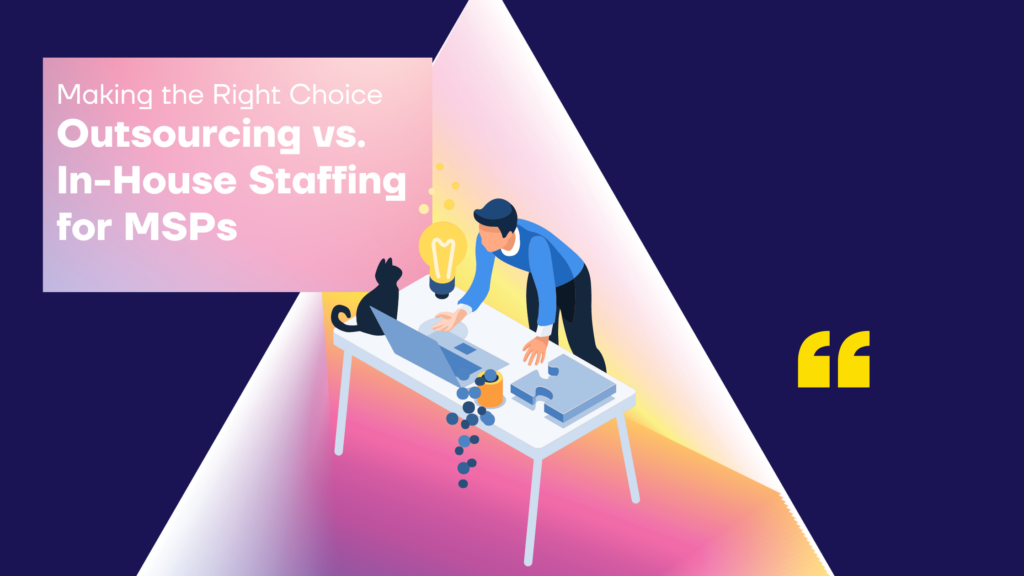
Assessing Business Needs
To decide between outsourcing and in-house staffing, MSPs should first assess their specific business needs and goals. This includes evaluating the nature of their services, client expectations, and internal capabilities. For example, an MSP focusing on highly specialized IT solutions may benefit more from in-house expertise, while those needing flexible support may find outsourcing advantageous.
Conducting a SWOT Analysis
A SWOT analysis (Strengths, Weaknesses, Opportunities, Threats) can help MSPs objectively evaluate the pros and cons of outsourcing vs. in-house staffing. This analysis provides a structured approach to understanding how each option aligns with the company’s operational needs and strategic goals.
Considering Hybrid Models
A hybrid staffing model, combining in-house and outsourced staff, can offer a balanced approach. This model allows MSPs to maintain control over core functions while leveraging the flexibility and cost benefits of outsourcing. For instance, an MSP might keep senior engineers in-house while outsourcing routine tasks to MSP staff outsourcing services, optimizing costs and efficiency.
Long-term Strategic Planning
Aligning the staffing decision with long-term strategic goals is crucial. MSPs should consider how their choice will impact future growth, market positioning, and client relationships. For example, if scalability and flexibility are priorities, outsourcing might be more suitable.
Final Words on Choosing Between Outsourcing vs. In-House Staffing for MSPs
In conclusion, the decision between outsourcing vs. in-house staffing is a critical one for MSPs, with each option offering unique benefits and challenges. Outsourcing provides cost efficiency, access to global talent, and scalability, making it an attractive choice for MSPs looking to expand their capabilities without significant overhead. However, it also comes with potential downsides such as quality control issues. On the other hand, in-house staffing offers greater control, albeit with higher costs and limited flexibility.
For MSPs, the best approach often involves a careful assessment of business needs, a thorough SWOT analysis, and consideration of hybrid models that leverage the strengths of both staffing strategies. Aligning staffing choices with long-term strategic goals ensures that MSPs are well-positioned to meet future challenges and opportunities. Ultimately, whether choosing to outsource, hire in-house, or combine both methods, the focus should always be on delivering consistent, high-quality service to clients. This strategic decision-making will help MSPs build a resilient and adaptable workforce capable of supporting sustainable business growth.


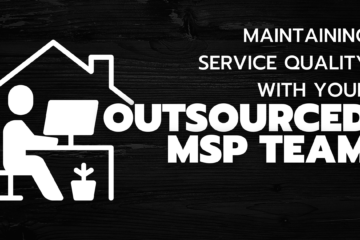
0 Comments